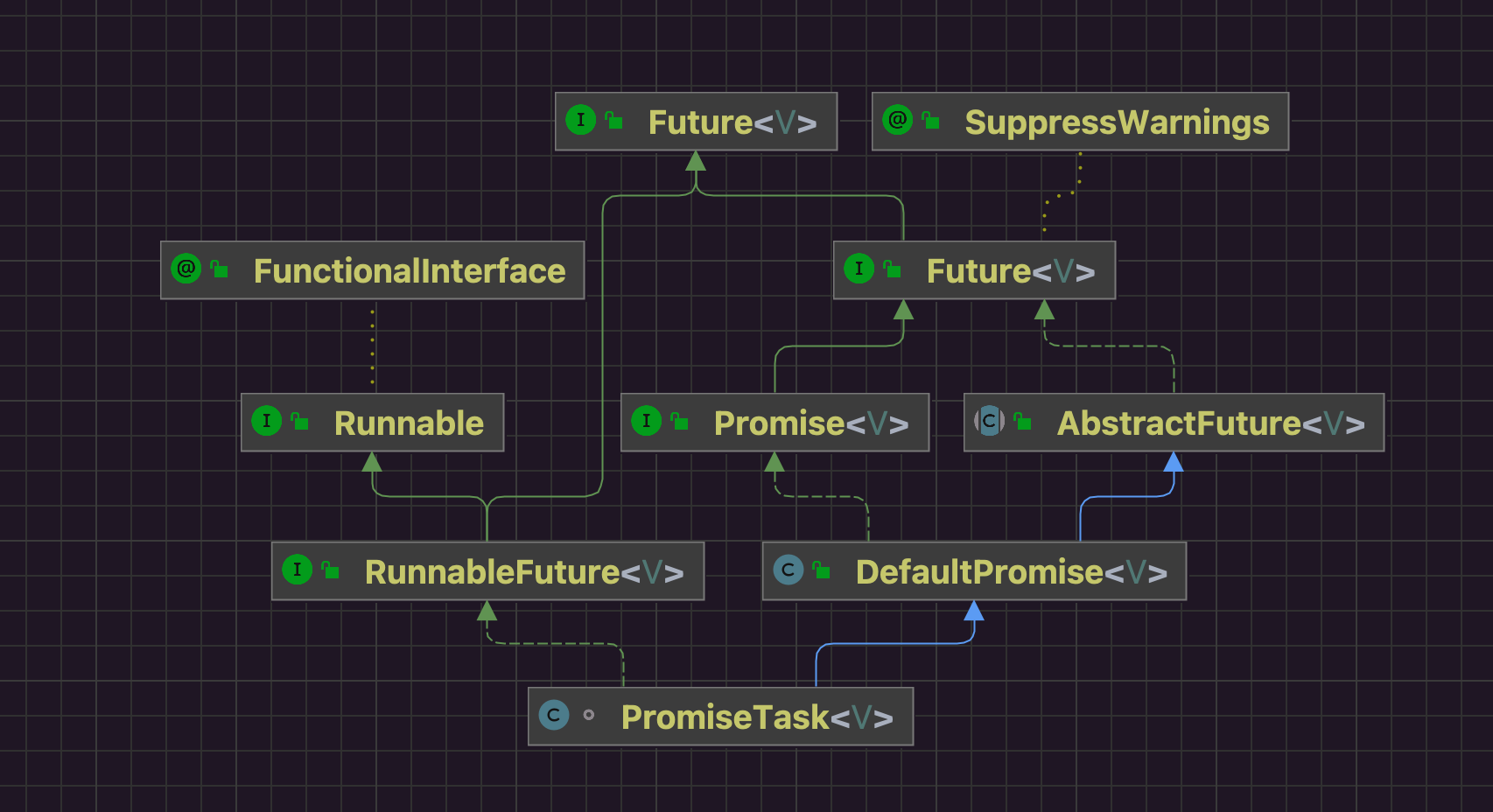Netty为了提高系统的吞吐,大量使用异步线程模型。
一 Demo 1 2 3 4 5 6 7 8 9 10 11 12 13 14 15 16 17 18 19 20 21 22 23 24 25 26 27 28 29 30 31 32 33 34 35 36 37 38 39 40 41 42 43 44 45 46 public class FutureTest00 {public static void main (String[] args) throws InterruptedException, ExecutionException {CountDownLatch latch = new CountDownLatch (3 );EventLoopGroup group = new DefaultEventLoopGroup (3 );"task..." );100_000 );return 100L ;new Thread (() -> {try {Long ans = f.get();"get..." + Thread.currentThread().getName() + " " + ans);catch (InterruptedException | ExecutionException e) {throw new RuntimeException (e);finally {"get" ).start();new Thread (() -> {try {Long ans = f.sync().getNow();"sync..." + Thread.currentThread().getName() + " " + ans);catch (InterruptedException e) {throw new RuntimeException (e);finally {"sync" ).start();new Thread (() -> {"future..." + Thread.currentThread().getName() + " " + f.get());"listen" ).start();
异步线程模型一定是依托于多线程实现的。
提交任务的线程负责提交任务,有专门的线程去关注任务过程,对于结果而言就有两种方式获取。
提交任务的线程自己去取,但是不知道什么时候执行线程才执行结束,所以可以阻塞等待执行线程的结果。
任务提交线程不要干等,通过监听器的回调机制,执行线程负责执行过程,自然知道什么时候执行结束,所以主动权交给执行线程,等有结果了让执行线程按照监听器的定义处理结果。
二 类图 三 任务提交流程 我们要关注ftask的实现类型是什么。
1 2 3 4 5 6 7 public <T> Future<T> submit (Callable<T> task) {if (task == null ) throw new NullPointerException ();return ftask;
1 2 3 4 5 @Override protected final <T> RunnableFuture<T> newTaskFor (Callable<T> callable) {return new PromiseTask <T>(this , callable);
四 sync阻塞等待 1 2 3 4 5 6 7 8 9 10 11 12 13 14 15 16 17 18 19 20 @Override public V get () throws InterruptedException, ExecutionException {Object result = this .result;if (!isDone0(result)) { this .await(); this .result; if (result == SUCCESS || result == UNCANCELLABLE) {return null ;Throwable cause = cause0(result);if (cause == null ) {return (V) result;if (cause instanceof CancellationException) {throw (CancellationException) cause;throw new ExecutionException (cause);
1 2 3 4 5 6 7 8 9 10 11 12 13 14 15 16 17 18 19 20 21 22 23 24 @Override public Promise<V> await () throws InterruptedException {if (this .isDone()) { return this ;if (Thread.interrupted()) {throw new InterruptedException (toString());synchronized (this ) { while (!isDone()) {try {finally {return this ;
现在获取任务的线程已经阻塞了,只能等待异步线程执行完任务之后,通过notify或者notifyAll唤醒这个阻塞线程了。
1 2 3 4 5 6 7 8 9 10 11 12 13 14 15 16 17 18 @Override public void run () {try {if (setUncancellableInternal()) { V result = runTask(); catch (Throwable e) {
1 2 3 4 5 6 7 8 9 10 11 protected final Promise<V> setSuccessInternal (V result) {super .setSuccess(result);true , COMPLETED);return this ;
1 2 3 4 5 6 7 8 9 10 11 12 13 14 @Override public Promise<V> setSuccess (V result) {if (this .setSuccess0(result)) {return this ;throw new IllegalStateException ("complete already: " + this );
1 2 3 4 5 6 7 8 9 private boolean setSuccess0 (V result) {return this .setValue0(result == null ? SUCCESS : result);
1 2 3 4 5 6 7 8 9 10 11 12 13 14 15 16 private boolean setValue0 (Object objResult) { if (RESULT_UPDATER.compareAndSet(this , null , objResult) ||this , UNCANCELLABLE, objResult)) { if (checkNotifyWaiters()) { this .notifyListeners(); return true ;return false ;
唤醒阻塞的线程。
1 2 3 4 5 6 7 private synchronized boolean checkNotifyWaiters () {if (waiters > 0 ) { return listeners != null ;
五 监听器回调 1 2 3 4 5 6 7 8 9 10 11 12 13 14 15 16 17 18 19 20 21 22 23 24 25 private void notifyListeners () {EventExecutor executor = executor();if (executor.inEventLoop()) {final InternalThreadLocalMap threadLocals = InternalThreadLocalMap.get();final int stackDepth = threadLocals.futureListenerStackDepth();if (stackDepth < MAX_LISTENER_STACK_DEPTH) {1 );try {finally {return ;new Runnable () {@Override public void run () {
1 2 3 4 5 6 7 8 9 10 11 12 13 14 15 16 17 18 19 20 21 22 23 24 25 26 27 28 29 private void notifyListenersNow () {synchronized (this ) {if (notifyingListeners || this .listeners == null ) {return ;true ;this .listeners;this .listeners = null ;for (;;) { if (listeners instanceof DefaultFutureListeners) {else {this , (GenericFutureListener<?>) listeners);synchronized (this ) {if (this .listeners == null ) {false ;return ;this .listeners;this .listeners = null ;
1 2 3 4 5 6 7 private void notifyListeners0 (DefaultFutureListeners listeners) {int size = listeners.size();for (int i = 0 ; i < size; i ++) {this , a[i]);
1 2 3 4 5 6 7 8 9 private static void notifyListener0 (Future future, GenericFutureListener l) {try {catch (Throwable t) {if (logger.isWarnEnabled()) {"An exception was thrown by " + l.getClass().getName() + ".operationComplete()" , t);
